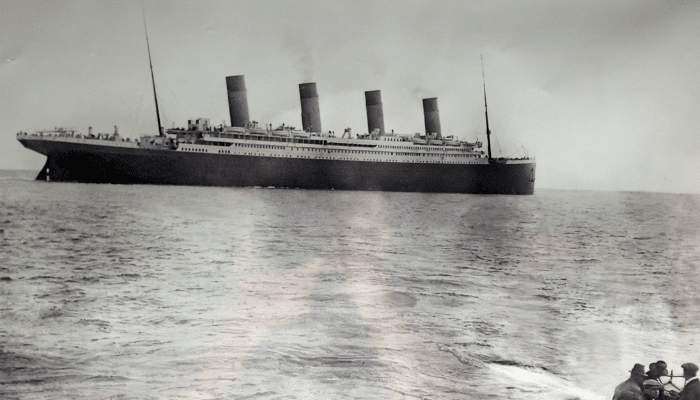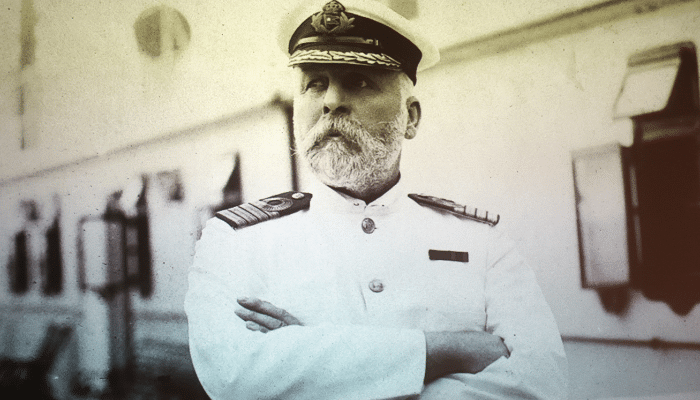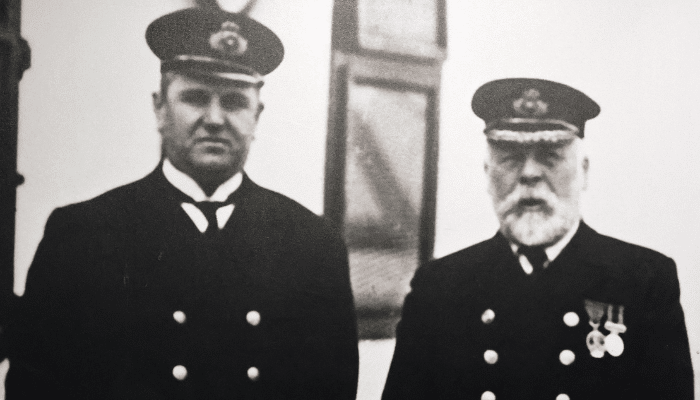10 Titanic Captain Facts You Might Not Know
“What was that, Mr. Murdoch?”
“An iceberg, sir.”
This iconic dialogue from the movie Titanic is so poignant that it sends a chill down the spine of anyone who has experienced this film.
This 1997 cinematic masterpiece vividly portrayed the tragic saga of the passenger ship’s ill-fated voyage through the icy Atlantic waters, cultivating an unwavering cult following.
While Jack and Rose undeniably captured a substantial audience, it was Captain Smith who truly endeared himself to many. Watching Captain Smith refuse a life jacket and lock himself in the bridge mere moments before the ship’s tragic descent was indeed a heart-wrenching experience.

Opinions regarding the performance of the captain in charge of the Titanic remain diverse, as legends have spawned various conclusions about him.
For many, Captain Smith was a courageous leader, while numerous others believe that a series of mistakes and miscalculations, including those of Captain Smith, ultimately sealed the tragic fate of the RMS Titanic on its maiden voyage.
This enduring fascination with Smith highlights the public’s continued interest in the subject. What are the varied accounts surrounding this venerable, white-whiskered skipper?
An experienced mariner who failed navigational test

Born on January 27, 1850, in England, Edward John Smith’s maritime career began as a teenager, inspired by his seafaring half-brother Joseph Hancock. At 17, Smith apprenticed on the American packet ship Senator Webber under Captain Joseph. He assumed his first command in 1877, steering the 1,000-ton trade vessel Lizzie Fennell. In 1887, at the age of 37, the same year he married Sarah Eleanor Pennington, Smith became the captain of the passenger ship Republic.
This opportunity marked the culmination of seven years of service with the White Star Line, starting as a junior officer. However, Captain Smith is believed to have originally failed his first navigation exam due to a lack of sufficient navigating skills. Nevertheless, Smith passed the test on his next attempt, receiving his Master’s Certificate in February 1888, and subsequently helmed numerous vessels in the future.
The captain of millionaires
Often affectionately called ‘E.J.,’ Captain Smith was a robust and well-liked figure among both his crew and passengers. His amiable nature endeared him to the affluent travelers, earning him the nickname “the Captain of Millionaires.” With years of experience and a sterling reputation, Smith became the top preference for the aristocracy of his time.
Smith’s distinguished career in the Royal Naval Reserve (RNR), where he retired as a Commander, included notable achievements. His affiliation with the RNR allowed his vessels to display the RNR’s Blue Ensign, contrasting with the typical Red Ensign flown by British merchant ships. While commanding the Majestic, Smith played a crucial role in ferrying British Imperial troops to the Cape Colony during the Second Boer War, earning him the Transport Medal from King Edward VII.
Smith’s pre-titanic career mishaps

Captain Smith, often regarded as a ‘safe captain,’ took pride in his nearly forty years at sea without major incidents. In a 1907 interview with the New York press, he claimed to have “never seen a wreck and never been wrecked.”
However, reports present a different narrative. Smith experienced his fair share of scrapes and near-misses during his maritime career. One notable incident occurred when Titanic’s sister ship, Olympic, collided with the Royal Navy cruiser HMS Hawke under Smith’s command in September 1911.
The collision shattered Hawke’s bows filled two of Olympic’s compartments, and twisted one of her propeller shafts. The Royal Navy placed blame on White Star, contending that Olympic’s displacement had drawn in the naval ship.
Even Titanic’s departure had its own mishap. While passing the moored liners New York and Oceanic during a coal strike-caused congestion, Titanic’s massive size and the resulting suction snapped New York’s lines, narrowly avoiding a collision and causing an hour-long delay.”
Captain’s absence during the Titanic collision
At 11:40 p.m. on Sunday, April 14, 1912, the Titanic collided with an iceberg while Captain Smith was away from the bridge, leaving his exact location and activities during that crucial moment a mystery. Reports indicate that Captain Smith had handed over the bridge to Second Officer Lightoller at 9:30 p.m., explaining, ‘I will just be inside.’
He returned to the bridge moments after the collision, raising questions about his absence despite multiple warnings of potential obstacles. On the day of departure, Captain Edward Smith received a report about a submerged wreck’s mast in the Atlantic.
By 7:30 p.m., the Titanic had received five warnings from nearby ships regarding heavy pack ice and numerous icebergs along its path. These facts lead to speculation about whether a more experienced senior captain could have prevented the collision.
However, reports also suggest that Marconi wireless operator Jack Phillips may have been unable to relay iceberg warnings to any officer due to his busy task of transmitting passengers’ personal messages.
Additionally, Cooper, the author of ‘Titanic Captain: The Life of Edward John Smith,’ proposed that the captain might not have been reacting to ice warnings, as they were essentially notifications from other ships about encountering ice in specific areas.
Captain’s poor decision-making in the Titanic tragedy
In the lead-up to its launch, Titanic was hailed as “unsinkable,” but it had to meet its destiny on its very first trip across the Atlantic Ocean.
Numerous accounts allege that poor decision-making by Captain Smith and others on board, both before and immediately following the incident, exacerbated its severity. The U.S. Senate and the British Wreck Commission investigations into the accident indicated that overconfidence and a lack of leadership were among the causes of one of the greatest disasters in maritime history.
It has been noted that Captain Smith’s experience, up until a year before the Titanic disaster, was limited to ships no larger than 24,000 tons, while Titanic and her sister Olympic were 45,000-ton ships.
Drawing from his prior experiences, Captain Smith believed that the Titanic had the capability to establish visual contact with any iceberg ahead of the ship in ample time to make the necessary maneuvers to avoid it. The head of the Senate investigative committee, Senator William Alden Smith, reportedly alleged that Captain Smith’s apathy towards danger was a direct and contributing factor to this needless tragedy.
Was Smith at fault for the high speed during the accident?
On the night the Titanic sank, many other ships in the icy Atlantic waters, with limited visibility, chose to turn off their engines. In contrast, the Titanic’s captain, who could push the ship to a top speed of 21 knots, kept the engines running at full throttle.
Numerous investigations into the tragedy have emphasized that this reckless speed made it exceedingly challenging to steer the ship when they spotted the looming iceberg, ultimately holding the person at the helm responsible for compromising passenger safety.
Persistent rumors have also suggested that Captain Smith may have become a scapegoat in the ambitious pursuit of Bruce Ismay, the Managing Director of the White Star Line, to secure victory in the competition for transatlantic passengers by completing a six-day crossing.
Conversely, conflicting accounts point out that the ship’s rapidly diminishing coal supply, exacerbated by the British coal strike, might have compelled the captain to conserve fuel by avoiding frequent stops and starts in the icy terrain.
Titanic’s alleged drunk captain
As previously discussed, for many, the lingering question of the captain’s whereabouts at the time of the accident remains unanswered.
Some contend that Captain Smith had spent the evening of the disaster at a formal dinner in the ship’s first-class restaurant before retiring to his cabin for the night. However, a recently discovered document alleges that the captain may have been drunk when the liner struck the iceberg.
According to reports, one survivor named Emily Richards claimed to have witnessed Captain Smith drinking in the ship’s saloon bar shortly before the disaster. In support of this assertion, historians who have examined the events aboard the ship following the iceberg sighting have suggested that Smith exhibited signs of confusion and absentmindedness, as if he had entered a state of shock.
The mystery of Edward Smith’s multiple deaths
The Titanic’s final plunge into the ocean occurred at 2:20 a.m. on the 15th of April, almost three hours after the vessel hit the iceberg. Several credible accounts have reported that the captain went down with the ship, and his body was never recovered.
However, there are vivid descriptions of Captain Smith’s last moments, as vivid as those of any person who has faced as many alleged deaths as he has. Some claimed to have seen him jump from the ship into the water, only to be swept away by a wave and even sucked down by the last remaining funnel of the vessel into the ocean.
Some early reports even suggested that the captain shot himself moments before the ship went down. One story told by Titanic fireman Harry Senior recounts that Smith jumped off the ship while holding an infant. He swam to a nearby lifeboat, handed off the child, and then swam back towards the Titanic, declaring, ‘I will follow the ship.'”
Captain Smith’s survival tales from the disaster
More intriguingly, many still dispute his death in that disaster altogether. Three months after the tragic Titanic event, a Baltimore resident named Peter Pryal made a remarkable claim. He asserted that he had spotted Captain Smith on the streets of the city on two separate occasions.
Pryal went further, claiming to have served as an officer aboard the White Star liner Majestic during Smith’s captaincy, engaging in conversations with him during these chance encounters. Allegedly, Captain Smith bid him farewell with the words, “Be good, shipmate, until we meet again.”
In a curious twist, a letter published in Life magazine in 1940 added a new layer to the mystery. This letter suggested that the captain had spent his final years as an elderly derelict in Lima, Ohio. This individual, who arrived in Lima three years after the Titanic disaster, acquired the moniker “Silent Smith.” Notably, he bore a striking physical resemblance to the ill-fated Captain Smith and displayed tattoos commonly associated with seasoned seafarers.
Was Captain Smith about to retire after the Titanic’s maiden voyage?
Another well-known story about Captain Smith revolves around the notion that the Titanic’s maiden voyage was intended to be his final one before retirement. Among the various anecdotes about the Captain, the idea of his planning to retire after the Titanic’s maiden journey endures, adding a poignant twist to the tragedy. Some people cite a report in The New York Times that stated Captain Smith would retire at the end of 1911 due to reaching his age limit as compelling evidence for this theory.
Some historians have also suggested that Smith might have retired after the Titanic’s maiden voyage as a token of gratitude from the White Star Line. However, another report from 1912 contradicted this notion, stating that Captain Smith would remain in charge of the Titanic until the company constructed “a larger and finer steamer,” indicating he wouldn’t retire after the Titanic first voyage.
Interestingly, some, including author Gary Cooper, have proposed that the White Star Line might have deliberately spread rumors of the captain’s retirement to attract passengers wishing to sail with the renowned captain. Ultimately, we remain uncertain if Captain Smith was indeed planning to retire after the Titanic’s maiden journey, as the voyage didn’t conclude as intended, leaving the truth about his retirement plans shrouded in mystery.
The Titanic tragedy brought forth a wave of blame directed at Captain Edward John Smith; a situation made more poignant by the ease of pointing fingers when the accused cannot defend themselves. However, amidst all the accusations and whispers, Captain Smith remains a hero in the hearts of many.
His final act of leadership in the Titanic’s dying moments has left an indelible mark. Smith’s unwavering commitment to placing the safety of his passengers and crew, especially women and children, above his own life, has earned him admiration as one of the bravest and most compassionate individuals in maritime history. His selfless actions stand as a powerful testament to his heroism and unwavering resolve in the face of adversity.
You Might Also Like To Read-
- Titanic Survivors – Some Noteworthy Stories You Must Know
- Get the Real Truth – Reason Behind the Sinking of Titanic
- 10 Ships Sunk By Accident with Iceberg
- Titanic vs Modern Cruise Ship: How Ships Have Evolved
Disclaimer :
The information contained in this website is for general information purposes only. While we endeavour to keep the information up to date and correct, we make no representations or warranties of any kind, express or implied, about the completeness, accuracy, reliability, suitability or availability with respect to the website or the information, products, services, or related graphics contained on the website for any purpose. Any reliance you place on such information is therefore strictly at your own risk.
In no event will we be liable for any loss or damage including without limitation, indirect or consequential loss or damage, or any loss or damage whatsoever arising from loss of data or profits arising out of, or in connection with, the use of this website.
Do you have info to share with us ? Suggest a correction
Disclaimer :
The information contained in this website is for general information purposes only. While we endeavour to keep the information up to date and correct, we make no representations or warranties of any kind, express or implied, about the completeness, accuracy, reliability, suitability or availability with respect to the website or the information, products, services, or related graphics contained on the website for any purpose. Any reliance you place on such information is therefore strictly at your own risk.
In no event will we be liable for any loss or damage including without limitation, indirect or consequential loss or damage, or any loss or damage whatsoever arising from loss of data or profits arising out of, or in connection with, the use of this website.
Latest Maritime Knowledge Articles You Would Like:
Subscribe To Our Newsletters
By subscribing, you agree to our Privacy Policy and may receive occasional deal communications; you can unsubscribe anytime.















